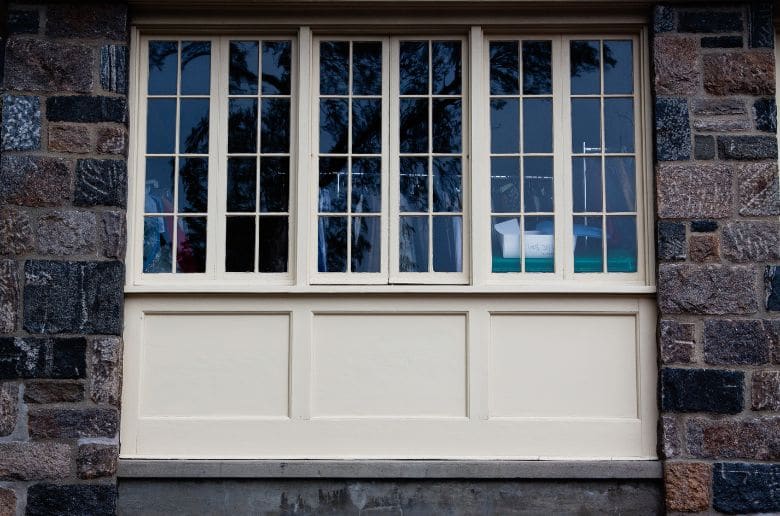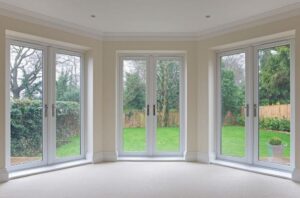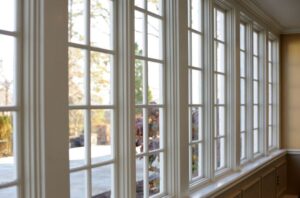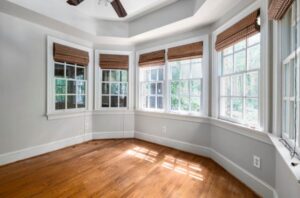When comparing Hayfield Windows vs Andersen Windows, we embark on a journey through their respective histories, innovations, and contributions to the window manufacturing industry.
Hayfield, established in 1951, has evolved from crafting aluminum storm windows to a diverse range of vinyl options. Andersen, since 1903, has grown to become North America’s largest window and door manufacturer, known for its energy-efficient and diverse product offerings.
Choosing the right windows is crucial in defining a home’s comfort, efficiency, and style. This comparison aims to offer clarity, comparing Hayfield’s dedication to affordability and durability against Andersen’s commitment to variety and innovative design.
Here, we’ll help you discern which brand aligns best with your home’s needs.
Comparison Table Between Hayfield Windows and Andersen Windows
| Feature | Hayfield Windows | Andersen Windows |
|---|---|---|
| Founded | 1951 | 1903 |
| Product Range | Single hung windows, patio doors, wood laminate | Wide range, including smart home options |
| Material | Vinyl | Wood, Vinyl, Fibrex, Fiberglass, Aluminum |
| Distinctive Features | Hopper 201 window | Pass-through window |
| Glass Options | BetterVue screens, ClimaGuard glass | Low E4 glass options (Heatlock, SmartSun, etc.) |
| Energy Efficiency | Foam-filled frames for enhanced efficiency | Energy Star award 2022, designed to save energy |
| Technology | Stainable vinyl, Duralite Spacer Bars | Stormwatch, VeriLock sensors, Perma Shield |
| Certifications | Energy Star, NFRC, AAMA | Energy Star |
| Warranty | Limited lifetime warranty | 20-year transferable warranty |
| Pricing | More affordable (Windows: $120-$1200) | Pricier (Windows: $680-$2500) |
| Customer Reviews | Mixed, concerns about quality and service | Varied, known for quality materials |
| Unique Selling Points | Durability, budget-friendly, energy efficiency | Material diversity, contemporary design options |
Overview Hayfield Windows
Hayfield Windows has carved a niche for itself in the window manufacturing industry, known for its resilience and innovation.
The Inception and Evolution of Hayfield Windows
Hayfield Windows’ story began in 1951 as a modest aluminum storm window and door fabricator. The company’s journey reflects a commitment to adapt and grow.
In 1985, Hayfield broadened its horizon by adding wood interior windows to its repertoire, followed by the introduction of vinyl windows in 1993.
This strategic expansion not only diversified their product range but also aligned them with evolving market demands.
Exploring the Product Range: From Aluminum to Vinyl
Hayfield’s product evolution showcases a significant shift from aluminum to more versatile and modern materials. The 1993 introduction of vinyl windows marked a pivotal moment, as vinyl offered both durability and aesthetic flexibility.
Hayfield’s vinyl windows come with options to mimic the classic appearance of wood, providing homeowners with the perfect blend of traditional style and modern functionality.
- Aluminum Era: Focus on storm windows and doors.
- Wood Interior Windows: Introduced in 1985, adding a touch of elegance.
- Vinyl Revolution: In 1993, embracing the new industry standard.
Key Features: Durability and Energy Efficiency
Hayfield’s commitment to quality is evident in their products’ durability and energy efficiency.
The 201 single hung model is a testament to this, boasting impressive performance data like an Air Infiltration (AI) rating of .02, a U-value of .27, and a Solar Heat Gain Coefficient (SHGC) of .37.
These numbers are not just statistics; they represent Hayfield’s dedication to providing windows that enhance comfort and reduce energy costs.
Customer Perceptions: Satisfaction and Concerns
While Hayfield has garnered satisfaction among users for its draft resistance, ease of cleaning, and smooth operation of patio doors, there are areas of concern.
Some installers have raised issues about the construction quality and customer service, particularly in handling replacements.
These concerns highlight the importance of continuous improvement and responsive customer service in maintaining a brand’s reputation.
Note: Customer feedback is integral to Hayfield’s growth, ensuring they remain attuned to consumer needs and expectations.
In conclusion, Hayfield Windows has shown remarkable adaptability and commitment to quality.
From its aluminum origins to the current vinyl offerings, the brand has strived to meet the evolving needs of homeowners, balancing traditional craftsmanship with modern technology.
Overview Andersen Windows
Andersen Windows stands as a testament to innovation and quality in the window manufacturing industry.
Andersen’s Journey as North America’s Leading Window Manufacturer
Andersen’s story dates back to 1903, establishing a legacy as the largest window and door manufacturer in North America.
This century-long journey is marked by consistent growth, adaptation to market trends, and a steadfast commitment to quality. Andersen’s growth trajectory, from a small workshop to an industry leader, reflects its dedication to excellence and customer satisfaction.
Diverse Product Innovations and Environmental Commitment
Andersen Windows is not just about variety; it’s about pioneering change.
The launch of Renewal by Andersen in 1995 and the investment in Ubiquitous Energy for energy-efficient products underscore their commitment to innovation and environmental stewardship.
These strides are not mere business expansions but are reflective of Andersen’s dedication to sustainable, energy-efficient solutions.
- Renewal by Andersen: Specializing in window and door solutions.
- Investment in Green Technology: Partnership with Ubiquitous Energy.
- Energy-Efficient Products: A step towards environmental responsibility.
Material and Design Versatility in Andersen’s Offerings
One of Andersen’s strongest suits is its vast array of materials and designs. From traditional wood to modern Fibrex, the range is tailored to meet diverse architectural styles and personal preferences.
Andersen’s offerings are a blend of aesthetic appeal, durability, and energy efficiency, catering to the varied needs of homeowners.
- Material Diversity: Wood, Vinyl, Fibrex, Fiberglass, Aluminum.
- Design Options: Custom shapes, energy-efficient options, smart home technology.
Installation and Warranty: Understanding Andersen’s Approach
Andersen’s approach to installation and warranty is unique.
While they don’t offer installation services, their comprehensive online manuals empower customers to either take on DIY projects or hire local contractors. This flexibility underscores Andersen’s confidence in their product’s ease of installation and quality.
Additionally, their warranty options, including a 20-year transferable warranty, provide long-term peace of mind to homeowners.
Important Note: Andersen’s warranty and self-installation approach reflect their trust in the quality and user-friendliness of their products.
Andersen Windows, through its innovative journey and diverse offerings, has carved a niche in the hearts of homeowners seeking quality, variety, and sustainability.
Their commitment to material versatility, environmental responsibility, and customer-centric policies sets them apart in the competitive window manufacturing market.
Key Comparison Hayfield Windows and Andersen Windows
Delving into the specifics, we compare Hayfield Windows vs Andersen Windows across various facets, from materials to customer satisfaction.
Material and Design: Vinyl vs Diverse Materials
Hayfield Windows primarily utilizes vinyl, a material known for its durability and ease of maintenance.
This choice positions Hayfield as a provider of practical, long-lasting windows with a focus on simplicity and functionality.
On the other hand, Andersen Windows offers a broader spectrum of materials, including wood, vinyl, Fibrex, fiberglass, and aluminum.
This diversity allows Andersen to cater to a wider range of aesthetic preferences and architectural styles.
- Hayfield Windows: Primarily vinyl for practicality and durability.
- Andersen Windows: Variety including wood, Fibrex, and more for aesthetic diversity.
Energy Efficiency: Comparative Analysis
When it comes to energy efficiency, both brands have made significant strides.
Hayfield Windows features models like the 201 single hung with an AI of .02, a U-value of .27, and an SHGC of .37, indicating high efficiency.
Andersen Windows, recognized for their energy-efficient designs, have won the Energy Star award in 2022. Their products are designed to minimize heat transfer, saving energy and reducing utility bills.
Product Range and Technological Innovations
Hayfield Windows offers a range of products including single, double, and triple-pane options, each with unique features like integrated nailing fin and Duralite Spacer Bars.
Andersen Windows, however, takes a step further with a wider variety of window types and advanced features like VeriLock sensors and Perma Shield technology.
- Hayfield’s Technology: Stainable vinyl, Duralite Spacer Bars.
- Andersen’s Innovations: Stormwatch, open/closed sensors, HeatLock technology.
Pricing and Customer Satisfaction: A Balanced View
In terms of pricing, Hayfield Windows are generally more affordable, with their products ranging from $120 to $1200 for windows. Andersen’s offerings, on the other hand, are on the pricier side, reflecting their diverse material use and advanced features.
Customer reviews for both brands vary, with Hayfield receiving mixed feedback regarding quality and service, while Andersen is often praised for its quality materials.
Note: Pricing and customer satisfaction are key factors in the decision-making process, reflecting the balance between affordability, quality, and service.
This comparison reveals that while Hayfield focuses on practicality and affordability, Andersen offers diversity and advanced technology, catering to different homeowner needs and preferences.
Which is Better? Analyzing for Different Needs
Choosing between Hayfield Windows vs Andersen Windows depends on individual requirements and preferences.
Comparing Durability and Maintenance Requirements
Durability is a key factor for long-term satisfaction. Hayfield’s vinyl windows are known for their resilience and low maintenance, making them a practical choice for those seeking longevity without extensive upkeep.
Andersen’s range, with materials like Fibrex and aluminum, also offers durability but might require different maintenance approaches depending on the material.
- Hayfield Windows: Vinyl for low maintenance.
- Andersen Windows: Material-dependent maintenance.
Tailoring to Aesthetic Preferences: Style and Design
When style is a priority, the choice becomes more nuanced. Andersen Windows provides a wider array of design options, from traditional to contemporary, to match various architectural styles.
Hayfield, while more limited in design variety, offers a classic look that appeals to many homeowners, especially those favoring traditional aesthetics.
- Andersen’s Variety: Broad range of styles and colors.
- Hayfield’s Classic Look: Traditional aesthetic appeal.
Budget Considerations: Affordability vs Premium Offerings
Budget is often a deciding factor. Hayfield Windows, with a price range of $120 to $1200, caters to those seeking quality within a modest budget.
Andersen, with its higher price point, targets the premium market segment, offering advanced features and a broader material selection.
- Hayfield: Budget-friendly options.
- Andersen: Premium, feature-rich windows.
Assessing the Ideal Choice for Specific Climatic Conditions
The choice may also hinge on the local climate. Hayfield’s vinyl windows are suitable for humid or high-moisture areas, providing excellent weather resistance.
Andersen’s diverse material range, including options like Fibrex, offers versatility for different climatic conditions, from extreme cold to heat.
Note: Climate plays a crucial role in choosing the right window material for efficiency and comfort.
In summary, the “better” brand depends on individual needs – whether it’s durability, aesthetic preference, budget constraints, or suitability for specific climatic conditions.
Both Hayfield and Andersen have their strengths, catering to different segments of the market.
Conclusion
In this comprehensive comparison between Hayfield Windows vs Andersen Windows, we’ve highlighted key differences and similarities, from materials and design to energy efficiency and pricing.
For potential buyers, the decision hinges on balancing personal preferences, budget constraints, and specific needs.
Whether it’s the durability and affordability of Hayfield or the diverse, innovative offerings of Andersen, each brand has its unique appeal.
Our final thought is to weigh these factors carefully, ensuring that your choice not only enhances the aesthetic of your home but also aligns with your lifestyle and values.
Making an informed decision in window selection is crucial for long-term satisfaction and comfort.





